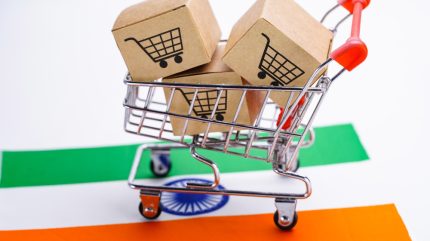
India’s e-commerce market is on course to pass $200 billion in 2025, with GlobalData forecasting 12.5% growth to INR17.7 trillion ($211.6 billion).
The research firm says momentum stems from “strong consumer appetite for online shopping and growing trust in digital payments,” underpinned by deeper digital integration, government support and AI-driven payment innovation.

Discover B2B Marketing That Performs
Combine business intelligence and editorial excellence to reach engaged professionals across 36 leading media platforms.
Looking further ahead, GlobalData projects an 11.5% CAGR from 2025 to 2029, taking the market to INR27.3 trillion ($326.7 billion) by 2029.
“The e-commerce market in India has experienced rapid growth in recent years,” said Poornima Chinta, Senior Banking and Payments Analyst at GlobalData.
Policy changes and GST Bachat Utsav” widen demand
The Indian government’s recent tax measures are expected to buttress discretionary spending and online sales.
A 100-day “GST Bachat Utsav” (Savings Festival)began on 22 September 2025, directing participating retailers to display GST discounts on invoices and report benefits passed on to consumers; major platforms including Reliance Retail, Amazon and Flipkart are taking part.

US Tariffs are shifting - will you react or anticipate?
Don’t let policy changes catch you off guard. Stay proactive with real-time data and expert analysis.
By GlobalDataReports from government-aligned and industry outlets describe the campaign as a push to transmit GST rate cuts on essentials and popular categories directly to shoppers.
Partnerships and startup support strengthen the ecosystem
GlobalData highlights collaboration between the state and private sector as another driver.
In December 2024, Amazon partnered with the government’s Startup India initiative to mentor founders and give startups access to tools and its marketplace—an effort aimed at helping small businesses scale online.
Amazon’s announcement and contemporaneous coverage confirm the programme’s focus on onboarding, training and go-to-market support.
AI payments and UPI integration reshape checkout
The rollout of AI-enabled commerce is accelerating India’s digital payments adoption.
In October 2025, a pilot integrated Unified Payments Interface (UPI) into ChatGPT, allowing users to discover products and pay inside the chat. Bigbasket is among the first platforms in the trial, with NPCI and Razorpay involved in the launch, according to multiple reports.
GlobalData’s release links this kind of innovation to rising consumer trust in online shopping and alternative payment methods.
Cards still matter as banks tie up with marketplaces
While UPI and digital wallets dominate everyday transactions, GlobalData notes that payment cards remain the second-most-used e-commerce instrument—particularly credit cards, which offer instalments, rewards and cashback.
Recent launches reflect that trend: State Bank of India and Flipkart unveiled a co-branded card in August 2025 with cashback on Flipkart, Cleartrip and Myntra.
Public materials outline benefits such as 5% cashback on Flipkart and Cleartrip and 7.5% on Myntra, with caps per quarter.
Chinta concludes that growth will remain resilient as demographics, payments innovation and policy reforms converge:
“India’s ecommerce market will continue its upward growth trajectory over the next few years… creating new market opportunities, improving customer experiences, and attracting fresh investment.”





